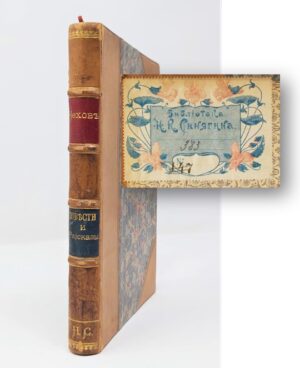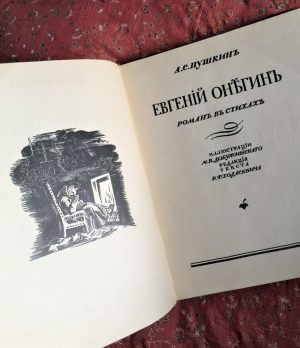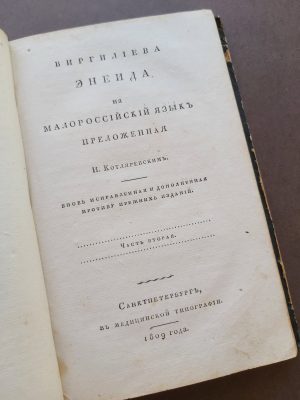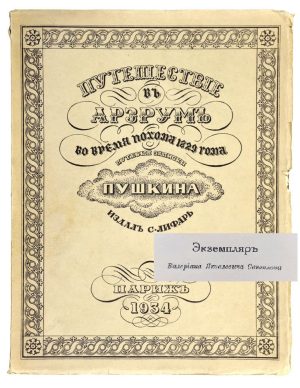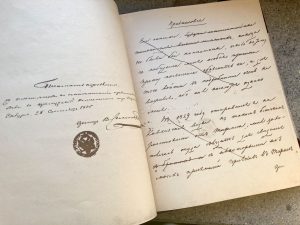Our Notes & References
The Black Monk‘s first book edition, together with Chekhov’s own favourite story, in a fine example in contemporary binding with distinguished provenance.
This edition is also sometimes referred as the “first edition of Chekhov’s stories”, because the previous collections included only short, mostly humorous pieces. After the success of The Duel, a longer story published by Suvorin in 1891, and of Sytin’s own edition of Ward №6 in 1893, the publisher decided to produce these Povesti i razskasy, eleven of the best and freshest stories: with the exception of A Father, the stories in the collection were written in 1892–94. The publication was a success, as Sytin published it again in 1898. In English, they will become widely known in 1917-20, when Constance Garnett’s translations (titles of which we used below) were published in London by Chatto & Windus.
The Black Monk is probably the best-known story in the collection: translated by R.E.C. Long, it featured as a title story in the first collection of Chekhov in English, published by Duckworth in 1903.
The story follows Andrey Kovrin, a Russian scholar suffering from a mental disorder: he has visions of a monk dressed in black, who tells him he is a genius. The story explores a line between sanity and insanity, as well as themes of ambition, selfishness and mediocrity. In his Preface to The Black Monk and Other Stories, Long defined Chekhov as a detached ‘satirist’, similar to Maupassant in his ‘brevity’ and ‘remorselessness’ (p. vii). However, in the original text we also find notes of beauty, for instance, in Kovrin’s last vision: ‘He cried to Tanya, cried to the great garden with miraculous flowers […] cried to his marvellous science, to his youth, his daring, his joy, cried to the life which had been so beautiful’ (Long’s translation).
The Student was, according to Bunin’s memoirs, Chekhov’s own favourite. Bunin remembered how Chekhov was offended when the critics labelled him as a ‘pessimist’, and to oppose this reputation, he referred to the plot of this story. The Student is a story about the renewal of faith and love for humanity with references to the New Testament narrative of the Resurrection.
Other stories from the collection were also highly considered by Chekhov’s contemporaries. For instance, Tolstoy praised The Teacher of Literature: “In it, so much is said with so little and with such skill; there is not a feature in it that is superfluous, and that is a sign of art” (Tolstoy, vol. 2 pp. 22-23).
Beside the stories mentioned above, the collection also includes «Бабье царство» (A Woman’s Kingdom), «Попрыгунья» (The Grasshopper); «Чёрный монах» (The Black Monk); «В ссылке» (In Exile); «Володя большой и Володя маленький» (The Two Volodyas); «Скрипка Ротшильда» (Rothschild’s Fiddle); «В усадьбе» (At a Country House) and «Соседи» (Neighbours).
Although dated 1894, the main printrun of the book happened in January 1895, after Chekhov had received his proof copies in late December 94.
Provenance
With fine provenance from the golden age of Russian bibliophilia
This is Siniagin’s copy, with his initials on the binding and his celebrated decorative art-nouveau floral bookplate to the upper pastedown.
Nikolai Kuzmich Siniagin (1873-1912) was an industrialist, philanthropist and an avid bibliophile at a time when rare-book collecting had reached its peak in Russia. Having received a large inheritance from his father, a successful grain merchant, he built and equipped a hospital at the Institute of Experimental Medicine in St Petersburg and then directed his funds to book collecting. His library contained over 20,000 books, prints, lithographs and watercolours, usually in excellent condition and sometimes put on his order in prestigious bindings.
In 1917, Siniagin’s library was bought by another prominent Russian collector, Pavel Vikentievich Gubar (1885-1976). When Gubar became a bookdealer in the 1920s Petrograd, he put many of Siniagin’s books on the market. Our copy has Gubar’s shop label on the lower pastedown.
Bibliography
Lesman № 2496; Kilgour, 232; Fekula, 4589; Notes on ‘The Teacher of Literature’ in Chekhov’s Collected Works in 30 Volumes (in Russian); Bunin, ‘O Chekhove’ [On Chekhov], New York, 1955; Masanov, Bibliography of Chekhov’s Works, 1906; L. N. Tolstoy v vospominaniyakh sovremennikov, 1960; Ivask II-85 for the ex-libris.
Physical Description
Octavo (19.4 x 13.7 cm). 285 pp. incl. title, [1] leaf table of contents. Half-title not called for, so the copy is complete.
Binding
Contemporary half calf over marbled boards, spine with raised bands and gilt fillets, a red and a green leather labels lettered in gilt, gilt initials to spine foot, endpapers with floral pattern.
Condition
Binding edges a bit rubbed, small area of abrasion to lower cover, hinges starting to split but holding, otherwise a fine, attractive example.









